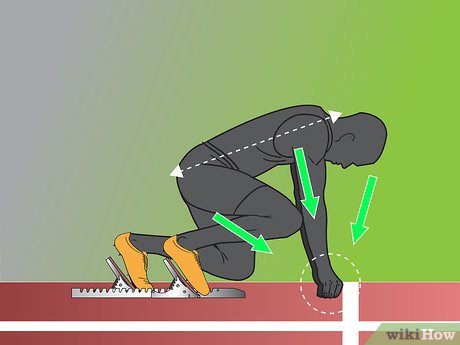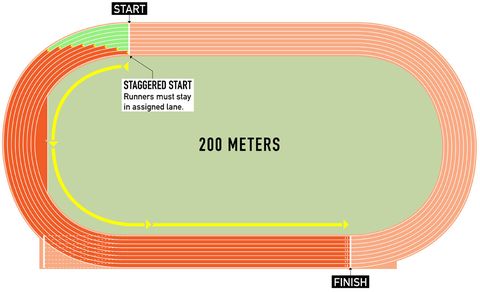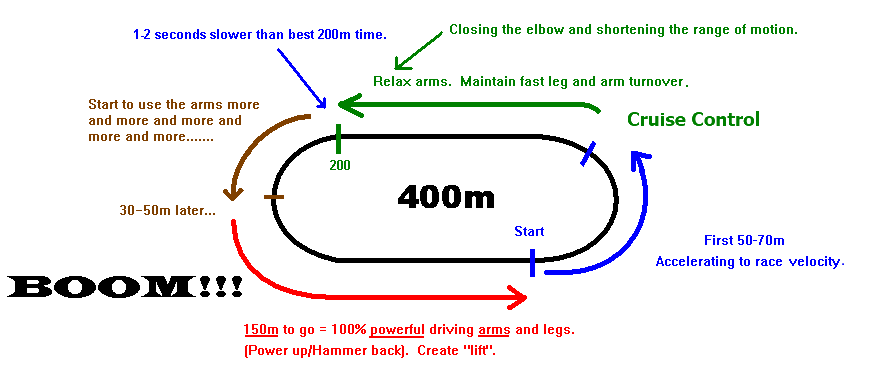How to improve your perFORMANCE in Athletics
In this section, we are going to highlight on the race tactics that an athlete can employ in order to win a race together with the training shedules for the various events so as to enable the athletes to train well .
The sprints
100 Meters
In this race, athletes start from starting blocks, it is therefore advised for one to place the front edge of the starting block one foot from the start line, the first block two feet from the starting line and the back block at three feet from the start line. After setting the starting blocks, one should go down on their knees, place your strong foot in front and quick foot that will make the first step on the back.

While on the blocks, once the announcer declares ‘ on your mark’ the athlete should resemble the position above . When the announcer declares set, raise the hips above the shouder and when the gun goes off, blast off from the block. Immediately after blasting from the blocks, one should make quick, powerful but short strides to enable them to make maximum contact with the ground.(remember, newtons third law) . In the drive stage(0-30/50 meters) one should keep their body low and transition smoothly after 30-40 meters to an upright position.( should however not slant backwards, air resistance will slow you down. After transition, aim to lift your knee high and stride as much as possible. Maintain to the finish.
200 meters
The 200 meters is the double of the 100 meters. It often attracts many athletes from both the 100 meters. People have aways commented saying that it combines of 400 meters speed enduarance and 100 meters speed. since the race begins in starting blocks , the 100 meters starting blocks technique, (remember to raise your hips above your head at the set position. When the gun goes off, push hard off the ground remembering to swing your arms . During the first 40 meters of the race, it is advisable that an athlete applies maximum pressure on the ground therefore generating maximum velocity. from then on, for the next 70 metres, it is advisable to maintain the momentum that you may have generated earlier in the race and maintain the same speed round the curve, however if you attack the curve, there are very many chances that you will get tired before the end. From 110 meters to 150 meters immediately after the curve, it is advisable to re-acccelarate to the maximum speed . In the last 50 meters of the race, the body will start feeling fatigued and start to lose your energy. It is therefore advisable that at this stage, one to maintain their form to avoid de-accelaring to a stop as everyone will be tired and it will be a matter of who can hold it for the longest.
400 meters
The 400 meters has been termed by many as a really rigorous course that requires a lot of speed enduarance. The race often attracts athletes from the 400 hurdles, the 800 meters and the 200 meters. Due to its rigorous course, it is impossible to run tis race at 100 % effort for the whole of the course.
Before the start , it is advisable to set the blocks similar to how you would set the blocks for 200 meters race. As any other sprinting event, starting stromg from the blocks for the first 50 meters can be very benefitial as it allows the runner to get to their maximum speed , this should set the pace for the race. (Starting slow may not be a good option as lactic acid will still catch up with you no matter how you start. It is therefore advisable to start strong so as to be able to get a lead advantage). After 50 meters of running, one should mantain the pace over the next 150 meters, however, it is advisable to use the legs more than the hands so as to enable the body to have little recovery. By 200 meters, the runner starts feeling fatigued, therefore, they should optimize the curve . This means that they should sprint round the last curve. By about 80 meters to go, lactic acid would have taken toll and the runner will start having a difficulty finishing. It is therefore best for one to mantain their tehnique as accelerating would be really impossible because of severe fatigue and lactic acid. At this stage , it is upon the runner to run mentally, most people would be tired and thus deaccelerating painfully.

THE RELAYS
4 by 100 meters
This is a track event in which is competed by teams rather than individual effort. In this event, baton exchanges can be very critical , speed is always an important factor. The race comprises of 4 runners each forming a relay team. Each runner is designated to run approximately 100 meters . There is an exchange zone of approximately 20 meters in which the incoming runner should have passed the baton to the outgoing runner, any baton exchanges should happen outside inside the exchange zones, if outside, the whole team will be disqualified. In this event, it is important that a team to arrange its runners well. For example
- The first leg runner should be a very fast starter. Furthermore he /she should be good at running curves at fast speed.
- The second leg runner should have both good recieving and handing skills. This is because they will require to know how to pass and recieve the baton well. Tall runners are particulary better at this point since they are not that great at running curves. This types of runner is one who is not very good at running curves.
4 by 400 meters
This is regarded as one of the most intresting relays. This is because in this relay, there are teams of which each team is required to have 4 athletes. Each of these athletes runs 400 meters and there is a 20 meters exchange zone between each 2 athletes. Although the race is often regarded as a sprint, it can also comprise of 800 meters runners, although it typically consists of 400 meters runners and hurdlers, some coaches might decide to include 100 and 200 meters athletes. The race is just bt a typical 400 meters race. However, only the first leg runner runs at their designated lane for the whole way . The 2nd leg runner runs at the designated team lane only for 100 meters , the other 2 runners are not required to run at any designated lanes.
In this race , the starting staggers are a little foward compared to those of a normall 400 meters race. This is due to the exchange zones. The 2nd leg runners are required to cut off to lane 1 at a designated position. (normally marked by space makers) The order at which the 2nd , third and last athlete stand at the exchange zone is normally determined by the position at which the incoming runner is at by the 200 meters point. If the athlete for example is at first position, the waiting runner should be standing as the first( counting from lane 1). The order then follows according to the position of the oncoming runner . (This rule should be taken seriously as it can lead to disqualification. ,eg jamaica's women team, doha 2019 WCH) The runners must also exchange the baton at the designated exchange zone, usually marked by triangles.
TACTICS & TIPS
THE HURDLES
100/110 Meters hurdles
400 meters hurdles
The middle distance
800 meters
The 800 meters race is regarded as the most tactical race . It usually comprises of a well balanced combination of speed, enduarance and tactical awareness. It also requires a very high anaerobic enduarance and lactic tolerance.
Below are the tactics to sucesfully tacklle this race
1. Starting Strategy (First 100 meters): - Start explosively but controlled. You want to establish a good position without burning out. - Use the staggered start to your advantage. Position yourself slightly ahead or behind a competitor to control the pace. It is however advisable to go to the front of the pack so as to avoid geting pushed and tassled.
2. The First 200 meters (First Lap): - Maintain a controlled but strong pace. Find your rhythm and settle into your race pace. - Focus on running smooth curves on the track's turns, using the inside lanes if possible.
3. The Second 200 meters (Middle of First Lap to 400 meters): - Gradually increase your effort, but avoid any sudden surges. The goal is to maintain a steady pace. - Keep an eye on your competitors. If someone makes a move, consider whether it's the right time to respond or if it's better to hold your position.
4. The Third 200 meters (Second Lap): - Around the 400-meter mark, prepare for a gradual acceleration. This is where the race begins to intensify. - Start to pass competitors if possible, but do so smoothly and without wasting energy. - Maintain good form and stride efficiency. Focus on the bend's curves and keep a strong posture.
5. The Final 200 meters (Last Lap): - As you approach the 600-meter mark, it's time to unleash your final kick. - Shift into a higher gear, increase your cadence, and sprint towards the finish line. - Use the adrenaline and crowd energy to push you through the final straightaway. 6. **Finish Line:** - Give everything you have left in the tank for the last 100 meters. - Lean into the finish line, maintain your form, and dip at the tape if necessary to secure victory.
7. Race Awareness: - Throughout the race, be aware of your surroundings and competitors. Adjust your strategy as needed based on their moves. - Stay mentally tough and stay focused on your race plan, even if others try to disrupt it.
8. Kick Timing: The timing of your final kick is crucial. Aim to start your kick with about 150-200 meters to go, gradually increasing your speed until the finish line.
9. Stay Relaxed: Keep your upper body relaxed to conserve energy and maintain efficient breathing.
10. Post-Race: After crossing the finish line, make sure to cool down with a light jog and some stretching to aid recovery.
Remember that race tactics can vary depending on your specific strengths and the competition, so adapt this plan as needed. Practice your race tactics in training to perfect your strategy for race day.
1500 meters
3000 meters/ steeple chase
The long distance events
5000 meters
it being a twelve and a half laps on the track, it requires a combinetaion 0f enduarance and some little speed. Below are some of the tactics one could use
1. Pacing: Proper pacing is crucial in a 5000 meters race. Start at a pace that is slightly below your goal race pace, and gradually increase your speed throughout the race. Many runners use "negative splits," where the second half of the race is faster than the first. This conserves energy for the latter stages.
2. Race Strategy: Consider your strengths and weaknesses as a runner. If you have a strong finishing kick, you might want to hang back in the pack and then make a strong move in the final lap or two. If you have better endurance, you can maintain a steady pace throughout the race.
3. Positioning: Try to find a comfortable position in the race pack without expending too much energy. Avoid being boxed in, but also avoid leading the pack unless you're confident in your ability to set the pace.
4. Surging: Occasional surges can be used to break away from a pack or catch up to a leading group. However, be cautious not to surge too frequently, as it can be draining. Save surges for strategic moments.
5. Drafting: In a 5000 meters race, drafting behind other runners can help conserve energy. Stay close to the runner in front of you to reduce wind resistance.
6. Mind Games: Stay mentally focused and positive throughout the race. Visualize your race plan, and stay confident in your training. Don't let negative thoughts or self-doubt creep in.
8. Course Familiarity: If possible, familiarize yourself with the track or course beforehand. Knowing the turns, hills, and any challenging sections can give you a competitive edge.
9. Kicking Strategy: If you have a strong finishing kick, be prepared to accelerate in the final 200-400 meters. This is where many races are won or lost.
10. Race Tactics: Pay attention to the race as it unfolds. If a breakaway group forms, decide whether to go with them or stick to your race plan. Be adaptable and willing to make strategic decisions based on the race's dynamics.
11. Training: Your race tactics should align with your training. Train specifically for the 5000 meters distance, incorporating interval workouts, tempo runs, and long runs to improve your aerobic capacity and endurance.
12. Race Simulation: Practice race scenarios during your training, including pace changes, surges, and kicking strategies. This will help you feel more confident and prepared on race day.
13. Race Execution: Execute your race plan with discipline but also be prepared to adjust it if necessary. The ability to adapt to changing circumstances is crucial in longer track races.
Remember that race tactics can vary based on your individual strengths, competition, and race conditions. It's essential to practice these strategies during your training to determine what works best for you and to build confidence in your race-day approach.
10,000 meters
Half marathon
Marathon
Additional events
The mile/1600 meters
5 km road race
10 km road race
Cross country runs
Bibiliography/sources
References
Coultman. (2019). How to Run the 200m Effectively. The Speed Project. https://www.thespeedproject.com/sprinting/how-to-run-200m/
David Muhiu. (21 C.E., April). Lets Run - Major Events. Lets-All-Run.mozellosite.com. https://lets-all-run.mozellosite.com/
Douglas, S. (2021, August 2). Soufiane El Bakkali of Morocco Wins the Men’s Steeplechase at the Olympics. Runner’s World. https://www.runnersworld.com/news/a37191504/2021-tokyo-olympics-mens-steeplechase-results/
Emery, L. (2016, May 27). 10 key tips on how to run a 10K. Runner’s World. https://www.runnersworld.com/uk/training/a774945/10-key-tips-on-how-to-run-a-10k/
Malik, Z. (2020, November 12). The Top 5 Most Loved Colors. Medium. https://medium.com/illumination/the-top-5-most-loved-colors-dde542d35f8a
October 2, T. B., & 2015. (2015, October 2). The Cost Of A Comic Book Hobby. The Billfold. https://www.thebillfold.com/2015/10/the-cost-of-a-comic-book-hobby/
Randall, A. (2022, February 23). How To Pace A 10K Run [#1 Tips & Strategy for All Levels]. Reveal Sports. https://revelsports.com/how-to-pace-a-10k-run/
Sayer, A. (2021, December 27). These Benefits of Running are Actually Backed by Science. The Manual. https://www.themanual.com/fitness/benefits-of-running/